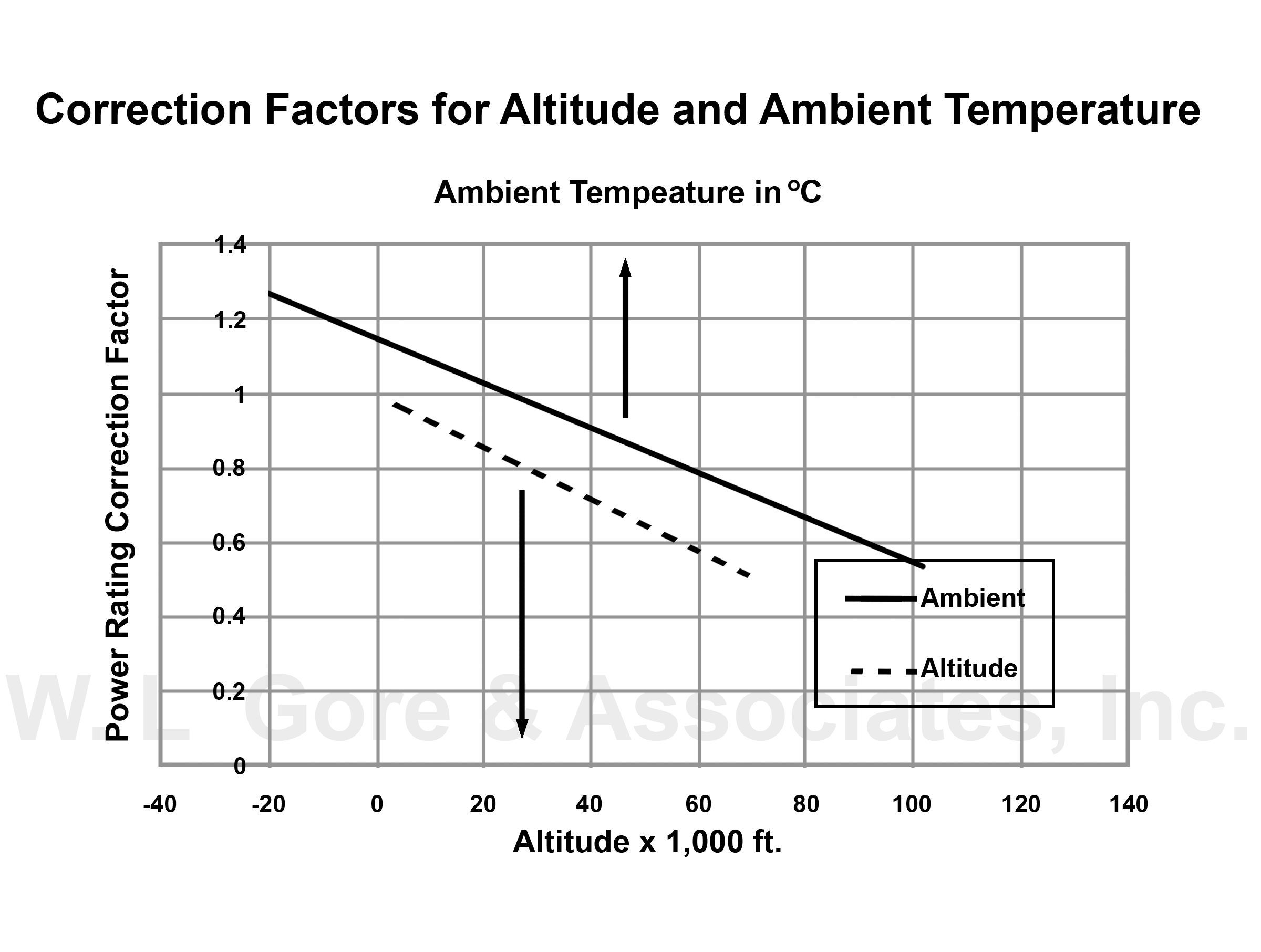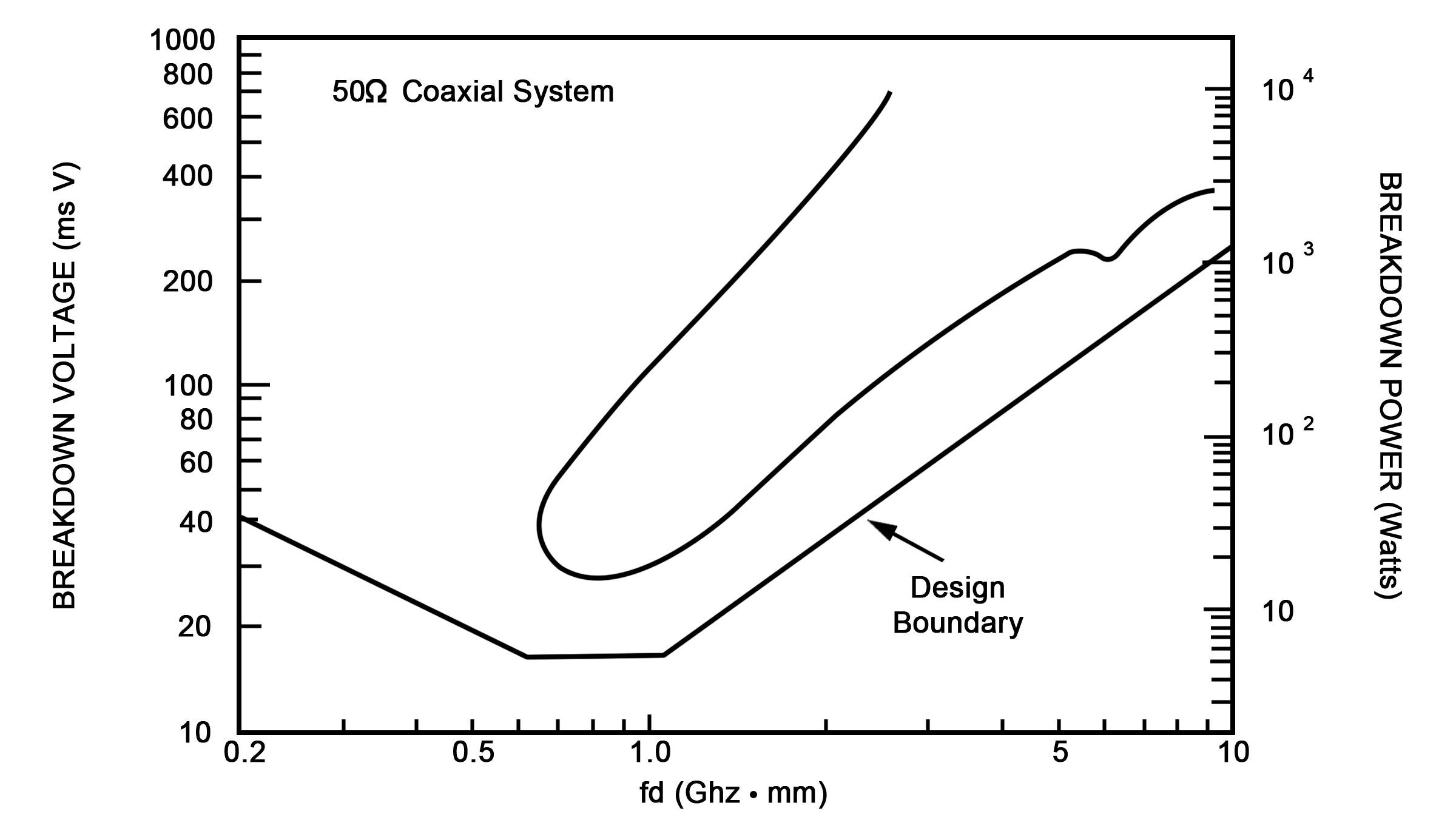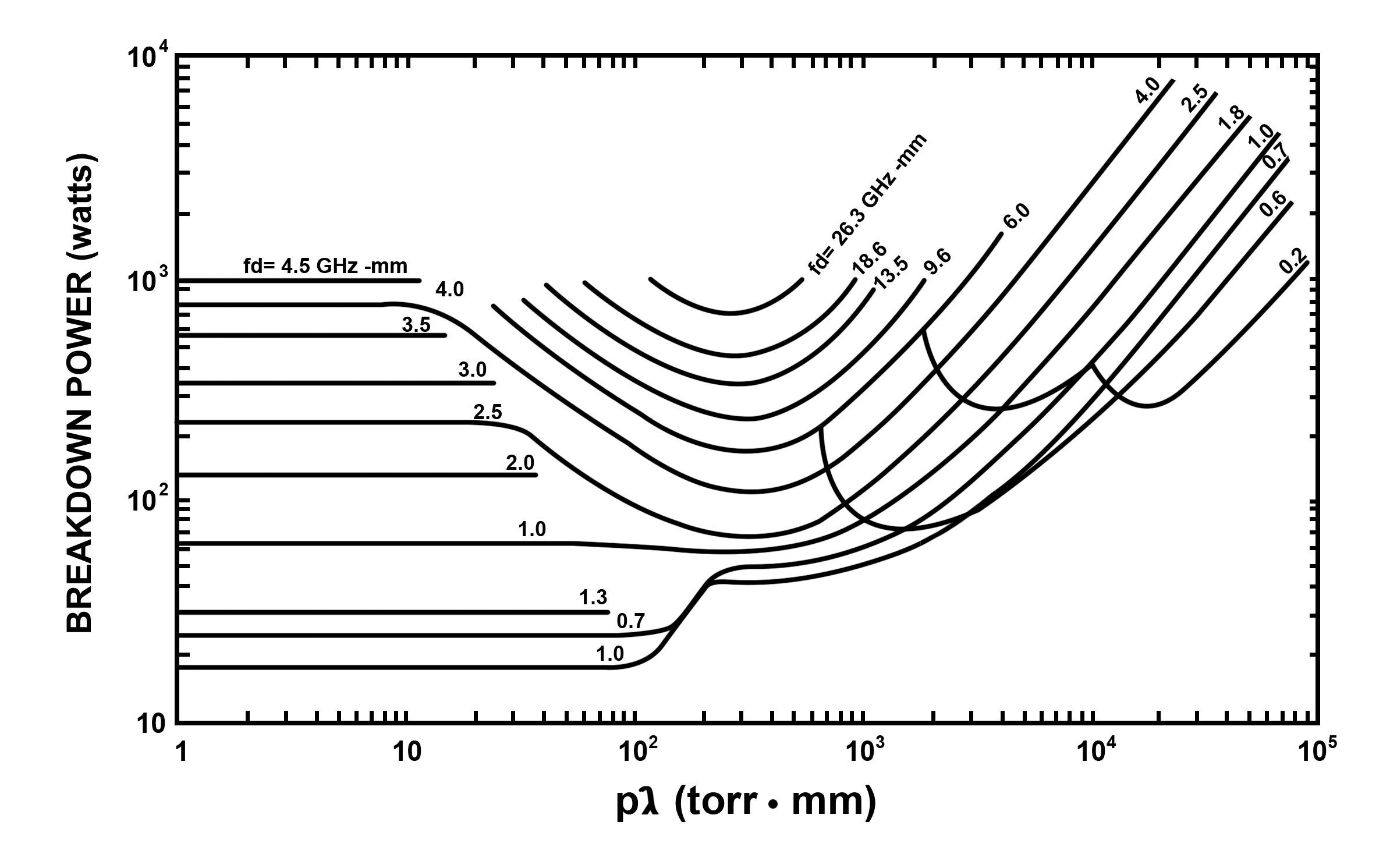High Power Operation of Coaxial Assemblies
One or more mechanisms may limit the operational power of a coaxial assembly during high-power operation. Perhaps the most common limiting mechanism is thermal breakdown. This is caused by heating within the cable and connector due to power dissipation. Less common, but equally important in a low pressure environment, are multipaction and ionization breakdown effects.
This discussion provides an overview of these effects and how they relate to a coaxial transmission system. Actual environments include additional factors that may affect the conclusions presented here.
Non-Spaceflight Applications
Thermal breakdown is a complex interaction of heating within the cable, connector, source, and load. A simple calculation that takes into account the loss-per-unit-length of the cable plus connector losses can determine the power dissipation of a cable. This calculation yields the total cable power loss. You can assume power dissipation to be uniform, provided the assembly does not operate in high VSWR/return-loss conditions. In this case, you may also need to calculate localized heating due to a current standing wave.
Given a certain level of heat generation within an assembly, thermal dissipation occurs through three primary mechanisms.
The first occurs longitudinally along the cable center conductor. Since approximately 50 percent of the heat is dissipated along the center conductor and the center conductor is almost 1,000 times better as a thermal conductor than the surrounding ePTFE, the ability of the source and load to dissipate heat play a significant role in power handling.
The second mechanism is radial conduction. Within the cable, a percentage of the heat generated within the center conductor passes through the ePTFE insulation and out through the cable exterior. Within the connector, a similar process takes place through the dielectric support beads. These thermal dissipation mechanisms may be enhanced using forced-air cooling along the cable and conductive strapping at the connector interface.
The third mechanism, radiant emission, is the weakest. In most terrestrial applications, the mechanism does not contribute significantly to thermal dissipation. In spaceflight applications, Gore uses a high emissivity (0.92) black jacket material to promote thermal dissipation; however, the other two mechanisms do the most to reduce the assembly temperature.
Given these complex characteristics, it is impossible to define one set of curves to predict the power handling of a coaxial assembly. The curves shown on the Approximate Power Rating graph represent estimates of a few select non-spaceflight assembly types. The Maximum Power Limitations curve represents estimates of a few select spaceflight assembly types.
Notes
- For mixed-termination assemblies, use the lowest curve for a given cable type to determine the assembly power rating. For example, for a G5 with an SMA on one end and a TNC on the other, use the SMA curve
Cables with additional layers, such as Gore ruggedized assemblies, may have lower power ratings
Derating of breakdown power with VSWR being the input to a cable assembly with termination-either matched or mismatched-and low insertion loss.
Please refer to the graphs Approximate Power Rating and Correction Factors for Altitude and Ambient Temperature, for rated power ambient factor and altitude factors.

In high-vacuum test applications, multipaction and ionization breakdown mechanisms may occur in an air section between conductors in the presence of a periodic RF/microwave field. Even in a dielectric-filled coaxial transmission line, air sections may exist between the inner and outer conductor at the connector interface.
At atmospheric pressures below 10-5 torr (approximately equal to an altitude above 100 miles), multipaction breakdown is the limiting mechanism. At higher atmospheric pressures, multipaction cannot exist and ionization breakdown is the limiting breakdown mechanism. Because both breakdown mechanisms are harmonic in nature, breakdown will only occur under a limited set of circumstances. Breakdown can be expressed in terms of the product between the conductor gap (d in mm) and the fundamental frequency (f in GHz). Referring toMultipaction and Ionization Breakdown Limits, multipaction is the dominating factor for f x d less than 0.7 GHz x mm. Above 2 GHz x mm, ionization breakdown limits power handling. Between 0.7 and 2 GHz x mm both mechanisms may be present.

Example: A three-foot G5S01C01036.0 with an input VSWR at the SMA end of 1.5:1 at 12 GHz would have the following power rating at 60°C.
Spaceflight Applications
Thermal breakdown is a complex interaction of heating within the cable, connector, source, and load. A simple calculation that takes into account the loss-per-unit-length of the cable plus connector losses can determine the power dissipation of a cable. This calculation yields the total cable power loss. You can assume power dissipation to be uniform, provided the assembly does not operate in high VSWR/return-loss conditions. In this case, you may also need to calculate localized heating due to a current standing wave.
Given a certain level of heat generation within an assembly, thermal dissipation occurs through three primary mechanisms.
The first occurs longitudinally along the cable center conductor. Since approximately 50 percent of the heat is dissipated along the center conductor and the center conductor is almost 1,000 times better as a thermal conductor than the surrounding ePTFE, the ability of the source and load to dissipate heat play a significant role in power handling.
The second mechanism is radial conduction. Within the cable, a percentage of the heat generated within the center conductor passes through the ePTFE insulation and out through the cable exterior. Within the connector, a similar process takes place through the dielectric support beads. These thermal dissipation mechanisms may be enhanced using forced-air cooling along the cable and conductive strapping at the connector interface.
The third mechanism, radiant emission, is the weakest. In most terrestrial applications, the mechanism does not contribute significantly to thermal dissipation. In spaceflight applications, Gore uses a high emissivity (0.92) black jacket material to promote thermal dissipation; however, the other two mechanisms do the most to reduce the assembly temperature.
1 The data in this chart assumes a two-foot free-floating cable, with connectors mounted to a 65°C plate and an ambient pressure less than 10-5 torr.
2 Return loss is better than 18 dB.
3 External heat sinking will increase thermal breakdown ratings.
4 Multipaction/Ionization peak power limitation is a function of the connector geometry.
In a nominal 50 ohm system, multipaction and ionization breakdown mechanisms may occur in an air section between conductors in the presence of a periodic RF/microwave field. Even in a dielectric-filled coaxial transmission line, air sections may exist between the inner and outer conductor at the connector interface.
At atmospheric pressures less than 10 -5 torr (approximately equal to an altitude above 100 miles), multipaction breakdown is the limiting mechanism. At higher atmospheric pressures, multipaction cannot exist, and ionization breakdown is the limiting breakdown mechanism. Because both breakdown mechanisms are harmonic in nature, breakdown will only occur under a limited set of circumstances. Breakdown can be expressed in terms of the product between the conductor gap (d in mm), and the fundamental frequency (f in GHz). Referring to theVoltage Breakdown Mechanism graph, multipaction is the dominating factor for f x d less than 0.7 GHz x mm. Above 2 GHz x mm, ionization breakdown limits power handling. Between 0.7 and 2 GHz x both mechanisms may be present.
Multipaction breakdown arises from a resonant-secondary-electron emission in the conductor wall. This mechanism requires a high-vacuum condition, where the mean free path of an electron is greater than the distance between the inner and outer conductors.
Under this condition, free electrons are accelerated by the electric field component of the microwave signal and strike the conductor surface, thus producing additional electrons. This electron cloud increases in intensity by being swept by half-wave (N=odd) cycles between conductor surfaces.
When the gap distance, microwave frequency, and electric fields support a resonant mode, the process is sustained, and an electron avalanche condition exists. This mobility-limited event increases until the mutual repulsion of the electrons limits the peak density of the electron cloud. The end result is discharge between the conductor surfaces, with an associated power density typically less than 10 mW/cm2. A venting mechanism is usually provided at the connector interface to prevent destructive pressure buildup during discharge. However, even non-destructive power levels can lead to data transmission loss, excess noise, and eventual connector failure.
The Multipactor Region for Coaxial Transmission Lines graph shows the extent of experimental multipactor data taken on a coaxial geometry conductor surface. Normalized to an f x d product, this demonstrates the comparatively tight set of conditions required for multipactor. In fact, multipactor is a unique mechanism in that it is possible to transmit at power above the multipactor region.

Although total available power is the usual desired result, multipactor stems from the electric fields present. Potential limits on the power are adjacent electric fields that can reduce or increase multipactor effects and VSWR effects due to poor matching conditions. Power handling is stated in an ideal 50-ohm system, and must be derated for VSWR >1. < /P >
As noted, a resonant condition must exist between the conductor surfaces to sustain multipactor breakdown. In addition to the primary power and f x d product constraints, four additional conditions must be considered when analyzing a system for multipactor:
1. A vacuum greater than approximately 10-3 torr must be present between the inner and outer conductor to enable electron transport. Thus you can interpose a dielectric material in the air gap or reconfigure the connector dimensions to prevent multipactor.
2. Electron generation at the conductor surface must be multiplicative to induce avalanche. In other words, for every incident primary electron, an additional fraction of secondary electrons must be produced. The measure of this effect can be represented as δ,where δ > 1 is sufficient for multipactor to exist. Because δ is strongly dependent on surface conditions, studies have shown the effect of contaminants and methods of reducing δ. Dust, fingerprints, and volatile substances resulting from outgassing can reduce power handling by between zero and six dB. This highlights the need to have a safe margin between the onset of multipactor shown in the Multipactor Region for Coaxial Transmission Lines graph and the design criteria. As yet, no lasting substance has been found to significantly increase power handling through a decrease in δ.
3. Multipactor is an electric field-driven event. As such, you must consider conductor geometry, the presence of external fields, and VSWR before you can determine power handling. For ease in theoretical calculations, most multipactor power rating curves presented in literature apply to parallel plate conductors. While these can provide a guide to the f x d region where multipactor can occur (parallel plate models offer conservative projections), E-field concentration at the center conductor of a coaxial line can significantly alter parallel plate rating curves.
4. A common misconception is that multipactor breakdown requires both the inner and outer surfaces to be conductive. This is incorrect; one or both surfaces may be insulated by dielectric. Although this will reduce the applied electric field across the gap, such regions must still be analyzed for multipactor.
Ionization breakdown occurs when a concentration of free electrons is generated through resonant collisions between electrons and gas molecules. This effect is less common than multipactor breakdown, as it requires partial pressure conditions that are unlikely to occur in space.
Unlike multipactor breakdown, which is a surface phenomenon, ionization breakdown is initiated in the air gap between the inner and outer conductor. During ionization, a high-energy short is realized between inner and outer conductors. Since there is no upper power limit to ionization, either the connector interface or an unprotected transmitter can be permanently damaged during this event.
In ionization breakdown, either the frequency the conductor surfaces. Hence, the electrons accumulate in a charge cloud that is swept between the conductor surfaces. With each pass of the electric field, the electrons interact with the molecules, causing additional charge accumulation and thermal dissipation. Limited by diffusion, this process continues until the energy density is sufficient to form a plasma arc between conductors.
Breakdown reaches a minimum when the energy transfer from the microwave field to the electrons is at a maximum. This point is referred to as the collision-frequency transition point. Below this pressure, the collisions decrease, the mean free path increases, and proportionally less energy is imparted to the electrons. At higher pressures, collisions increase, the mean free path is decreased, and the breakdown voltage increases

In the RF Voltage Breakdown in Coaxial Transmission Lines graph, the ionization and multipactor power limit for a set of f x d contours is plotted against a normalized pressure-wavelength axis. In a spaceflight mission with continuous transmit, it is useful to calculate the worst-case pressure for ionization. Referring to the graph, the f x d contours for most useful geometries go through a minimum at:
(1) p/f = 1 torr/GHz (approx.)where c=fλ and where p is pressure in torr and f is the fundamental frequency in GHz. As a simple example, suppose f equals 4 GHz and d equals 2.5 mm. Then, the f x d product is 10 GHz x mm and a minimum breakdown occurs at:
(2) p/4 GHz 1 torr/GHz < = > p ±4 torr< BR> Working across to the power axis, the maximum transmit power = 260 W (approx.).
As depicted in the graph, there is a slight negative slope to the minima of points on the f x d contours such that for f x d=25 GHz x mm, p/f = .9 torr/GHz and for f x d = 2.5 GHz x mm, p/f = 1.5 torr/GHz.
As a practical matter, the ionization phenomenon is constrained to a very narrow set of pressures and f x d products. In most circumstances, thermal dissipation rather than ionization will limit the peak transmit power.
Acknowledgments
The data used to generate the Voltage Breakdown Mechanism graph, Multipactor Region for Coaxial Transmission Lines graph, and RF Voltage Breakdown in Coaxial Transmission Lines graph is largely based on measurements obtained from Reference 1.
References
- R. Woo, 'Final Report on RF Breakdown in Coaxial Transmission Lines,' NASA Report 32-1500, October, 1970.
- P.F. Clancy, 'Multipactor Control in Microwave Space Systems,' Microwave Journal, March 1978, pp 77-78, 81-83.
- D. Woode and J. Petit, 'Design Data for the Control of Multipactor Discharge in Spacecraft Microwave and RF Systems,' Microwave Journal, January 1992, pp 142-155.
- J. Rodney M. Vaughan, 'Multipactor,' IEEE Trans. Ed., Vol. 35, No. 7, July 1988, pp 1172-1180.
- N. Rozario, et al. 'Investigation of Telstar 4 Spacecraft Ku-Band and C-Band Antenna Components for Multipactor Breakdown,' IEEE Trans. Ed., Vol. 42, No. 4, April 1994, pp 558-572.
FOR INDUSTRIAL USE ONLY
Not for use in food, drug, cosmetic or medical device manufacturing, processing, or packaging operations.




